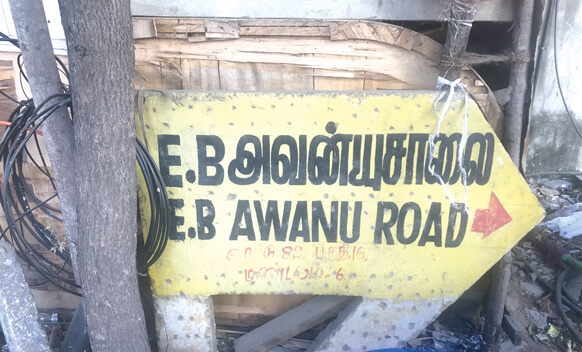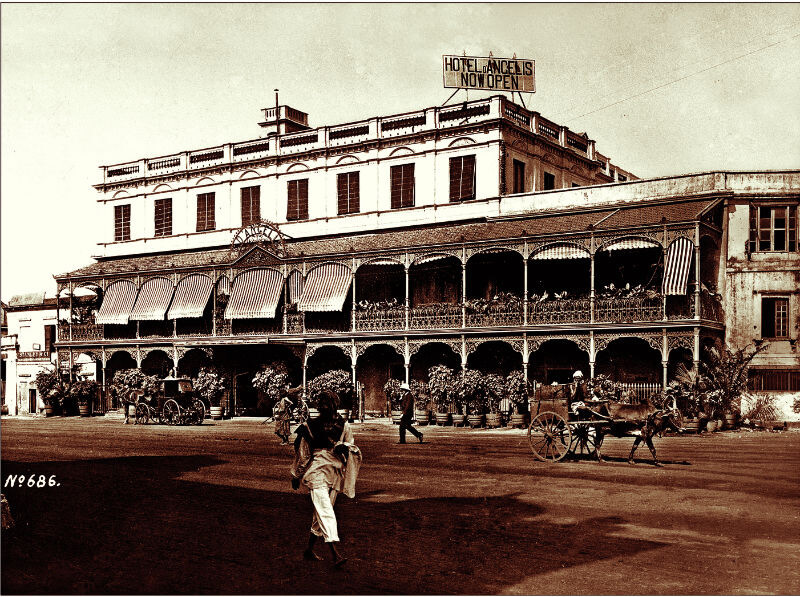Registered with the Registrar of Newspapers for India under R.N.I 53640/91
Vol. XXIX No. 22, March 1-15, 2020
Lost Landmarks of Chennai
By Sriram V
When Madras clothed the Army

 The spelling is enough food for thought but the history of this thoroughfare is even more interesting. next fortnight)
The spelling is enough food for thought but the history of this thoroughfare is even more interesting. next fortnight)
Among my favourite research materials are the old street directories of Madras that is Chennai. From these you can get a fairly good idea of street names, the names of thoroughfares to which they linked up and also, if you are really lucky, the details of some landmark buildings that stood on them. A recent perusal had me scratching my head about ACD Street. The directory, dating to the 1930s, was not very helpful – the street branched off Mount Road and terminated in a cul de sac.
A look at Eicher’s Street Directory did not show any such thoroughfare. For all practical purposes, I had, like ACD Street, wound up in a dead end.
Not having given up, I looked up other sources and soon found that ACD stood for Army Clothing Depot. That led me on a long trail of when Madras was one of the principal sources for supplying army uniforms. The earliest reference dated to 1809, when T. Boles, formerly Deputy Adjutant General and suspended from service for transgressions unknown, requested that he be allowed to return to England and that “the agency for army clothing, for the purpose of completing the year’s clothing now on hand,” may please be handed over to his brother, Lt. Boles of the 9th Native Regiment. It is not clear if the authorities acceded to the request but it appears that early in the 19th Century, army clothing was sub-contracted to Company officials.
Within a few decades, the three Presidencies had their respective army clothing depots and from the records, it is possible to glean that the one in Alipore, Calcutta, was opened in 1852. Probably the facility in Madras too dates to the same time. Post the Crown taking over the administration of India in the late 1850s, matters appear to have become more streamlined. The city had an Army Clothing Department, and as per Standing Information Regarding the Official Administration of the Madras Presidency (1877), supplied “the whole of the Madras Army, European and Native. The material is obtained from England and is made up under contract by native workmen.” It is evident that by this time, apart from tendering out much of its requirements, the clothing department was also into producing garments. The same article noted the extensive use of sewing machines in the premises. By 1879, all three Presidencies had full-fledged sewing facilities.
The Madras factory was located in the old Mint Buildings, Black Town, which is where the Government Stationery Press now functions from, at the northern end of Mint Street. The address is given out rather quaintly as Late Mint, Black Town, Madras. There was, however, soon talk of rationalising the various functions of the three Presidency armies, an essential step towards the formation of a pan-Indian force. By the 1880s, efforts in this direction had been stepped up and the clothing agencies across the three Presidencies were centralised. Calcutta was where the Director of Army Clothing sat and all the locations reported to him.
It is not clear as to when the Bombay facility closed but by the first decade of the 20th Century, the Alipore and Madras units were the sources of all army clothing and produced around 40,000 garments per month. This was to rise sharply during the First World War, when the two units together, along with a newer facility inaugurated in Shahjahanpur, made available over 42 lakh garments and 22 lakh pairs of boots. By then, the Army Clothing Factory in Madras had moved out of the Mint into newer premises on Mount Road, this shift happening in 1912.
The Indian Empire Royal Book of that year gives some idea of the organisation of the factory. A Superintendent of the rank of major was in-charge with an Assistant Superintendent under him. Further down were a Head Clerk and a Head Accountant (both Indians), an In-Charge of Supply, an Auditor, a Master Tailor, two Assistant Master Tailors, an Overseer in charge of Packing, and Storekeepers.
It was while at Mount Road that the factory made it to the news for all the wrong reasons. On July 31, 1917, a search was made at the premises of E.D. Smith, a tailor doing business on Mount Road. Captain Philips, an officer of the Army Clothing Department led the raid and found 20 bales of canvas in a well at the rear of the shop. Earlier in the day, a brougham with 88 flannel shirts, all with army markings (a broad arrow followed by an M for Madras), was stopped near Neil’s Statue and taken to the police station opposite Spencer’s. A subsequent stock-taking at the factory revealed that the shirts were part of a consignment meant for locations in western India.
During interrogation, Smith confessed that he was hand in glove with some tailors in the factory but hesitated in revealing their names as that would mean exposing “clerks, Muhammadans and guard peons.” Clearly it was quite a long-standing racket that had been exposed and the trial at the Chief Presidency Magistrate’s Court ended in conviction, which was upheld on appeal by Justice Ayling in the High Court of Madras.
By 1922, the army had four clothing factories – Shahjahanpur, Alipore (Calcutta), Patna and Madras. Of these, the last-named employed the maximum numbers – 1,246, as opposed to Shahjahanpur’s 1,073, the other two stations having a payroll at less than 500. However, it was clear even then that the Sahjahanpur unit was the one that was looked upon as being with potential for expansion and there was speculation that the others would be closed in its favour, this being considered even a subject worthy of a backbencher’s question in the House of Commons. By 1924, this became reality and the Madras unit fell silent. There were frequent talks of its revival but all of it came to nought.
In 1934, the Office of the Inspector General of Prisons shifted from Ootacamund to Madras and was housed in the premises of the Army Clothing Factory, but complaints were rife about the building and its unsuitability.
The Second World War saw a sharp rise in demand for army clothing and in 1940, the Army Clothing Factory in Madras was reopened. The new facility was at the workshops of the Madras and Southern Mahratta (M&SM) Railway, Perambur, the land on which the loco works now stands. This was one of a chain of several clothing factories, all of them on railway land – the others being in Agra, Lahore, Delhi, Secunderabad and Calcutta. Post the war, all of these were closed, the Shahjahanpur unit being the sole survivor and by then, given the status of an Ordnance Clothing Factory. In 1961, a second such facility was inaugurated in Avadi, Madras and till date manufactures combat shirts and jackets, trousers, tents, disposable shirts and parachutes.
What of the Mount Road premises in the meanwhile? The Inspector General of Prisons having moved out in the 1940s, the building was acquired by the Madras Electric Supply. This became the head office and survived into the 1990s when it was finally demolished to make way for a brand new (and quite ugly) office block for the TNEB. It was thanks to this that I discovered where the Army Clothing Factory once was. It was inside a lane that is between Rayala Towers and Addison & Co. The factory was therefore on historic land- it occupied the space between the erstwhile Eastern and Western Castlets of Thomas Fiott de Havilland, those two structures having given way to Rayala Towers and Addisons. It was therefore on this land that de Havilland demonstrated the structural stability of the dome as built by Indians and which technology he eventually put to use while building St Andrews Kirk.
Electricity Board Avenue leads to the TNEB (now Tangedco) building. This clearly was the ACD Street that originally set me off on this trail. And there is added proof at the blind end – a lovely army bungalow set in a large garden and occupied by a senior officer. It is most unexpected and is a thing of beauty in an incongruous setting. But then Chennai is full of surprises like that.

